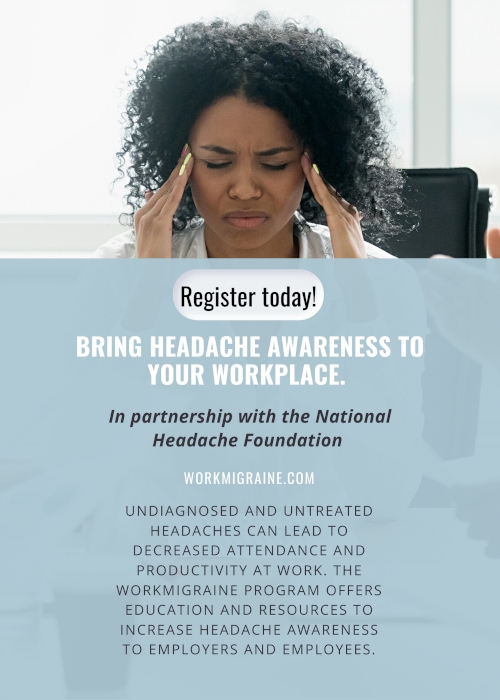How to Bring Health Fairs Back to the Workplace
Wednesday, June 2nd, 2021
The past year and a half have been full of uncertainty about our health as a society. Ironically, it also caused us to put a hold on the promotion and education of health in the workplace. Like so many other businesses, we had to get creative to stay afloat! We created a personalized virtual health fair option. Our mission to bring health to the workplace slowed, but it never stopped.
As people become more comfortable with the world post-pandemic, there’s a growing awareness of the importance of our overall health. Now is the time to get back to in-person health fairs. Let us help you find the value in moving beyond the virtual world and coming back together to bring health to your workplace.
Boost Morale
It’s been a difficult time for everyone. Lives were turned upside down, some lost jobs; others lost loved ones. Mental health issues are at an all-time high, and fear has run rampant throughout our nation. What we all need now is a sense of normalcy.

Bringing people back together for an in-person health fair provides many opportunities to improve mental health and morale. Interacting with others in a controlled health fair setting boosts confidence in the safety of the workplace.
Giving health vendors a place to fully showcase their products and services helps boost the economy. As we interact at a health fair, we build connections and education in a way that cannot be achieved in the virtual world.
Encourage Wellness
Now more than ever, individuals are focused on their health. We are hyper-aware of its importance. When we bring in-person health fairs back to the workplace, we communicate how important health is. We also give people the tools to care for their health.
There is no better way to promote wellness and a healthy immunity than with person-to-person interaction. There is an accountability to in-person relationships that can be more easily ignored when we are sequestered away from one another.
As we once again promote health and wellness in our workplaces, we also contribute to lessening the spread of every disease. It has to begin at an individual level. As we encourage that personal responsibility, we make the world a safer, healthier place.
Safety Precautions
While many mask mandates have been lifted, some employees may still feel most comfortable wearing a mask. Having things like hand sanitizer and masks available for use are a great way to set employees at ease.
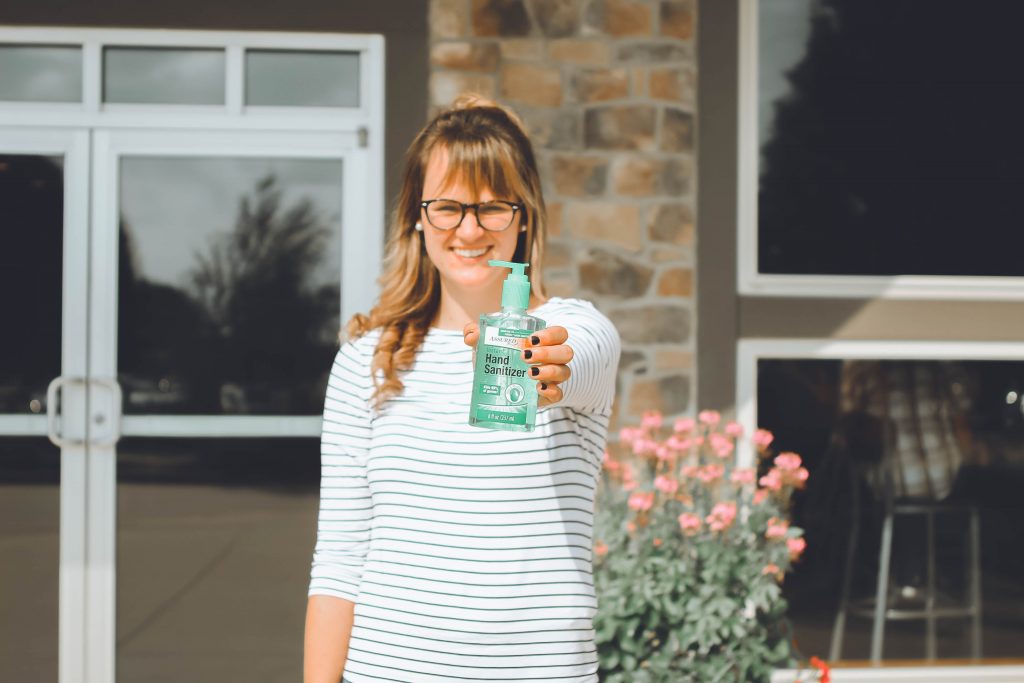
Be sure the facility you are using for your health fair has plenty of open space. Consider hosting your event outside. For your indoor event, provide specific time slots for groups of employees to attend. This can decrease the total number of people attending at one time. It can also allow each employee to seek out the information they need without waiting in line or standing in a crowd.
Listen to your employees and any needs and concerns they may have. We can accommodate most things to allow for an environment that feels safe and secure.
We are a resilient society. We have gained so much in the way of creativity and ingenuity over the past year or so. When challenges arise, we meet them and rise above them. That is how we grow! We will continue to grow and spread health and wellness. We look forward to seeing everyone in person at many health fairs to come.
5 Healthy Sleep Habits
Sunday, January 19th, 2020
We hear a lot about a healthy diet and an active lifestyle when it comes to wellness. There’s a third element to a healthy lifestyle that is often ignored or deemphasized: healthy sleep. It may be challenging or near impossible to get our recommended eight hours of sleep. Our efforts to lose weight, maintain top performance at our jobs and our interactions with other people all rely on our sufficient rest.

Here are five healthy habits to ensure your body gets the rest it needs to function best.
1. Stick to a Schedule
It can be tempting to stay up late and sleep in on weekends, but we really set ourselves up for a difficult work week. Our bodies have an inner “clock”. Our brain knows when it’s day time or night time based on our sleep schedule and cycles. When we mess with the time frame by dramatically changing our sleep habits a few days a week, we can spend the rest of the week making up for it.
2. Limit Caffeine Intake
 When we are tired, it’s easy to turn to coffee or soda as a quick pick me up. A cup or two of coffee in the morning can be beneficial. But studies have shown that those who drank four or more caffeinated beverages in a day were more prone to insomnia. On those especially difficult days, it’s best to go for a quick walk outside or rest your eyes for a moment to refresh yourself. Powering through until an early bedtime is your best bet for making up that sleep deficit.
When we are tired, it’s easy to turn to coffee or soda as a quick pick me up. A cup or two of coffee in the morning can be beneficial. But studies have shown that those who drank four or more caffeinated beverages in a day were more prone to insomnia. On those especially difficult days, it’s best to go for a quick walk outside or rest your eyes for a moment to refresh yourself. Powering through until an early bedtime is your best bet for making up that sleep deficit.
3. Have a Nighttime Routine
As infants and children, we typically had some type of nighttime routine. It may have consisted of a bath, a bedtime story, and a lullaby. The things signaled our bodies and brains for sleep. Why not establish a regular routine in your adult life to achieve the same end?
Incorporate a relaxing yoga routine into your evening activities. Turn off the TV and put away your phone for some quiet reading before bed. Even as little as fifteen to twenty minutes of reading can help your mind settle down from the constant stimulation of the day.
4. Exercise

Regular exercise in your week can help promote the hormone melatonin, known as the “sleep hormone.” Just make sure your exercise isn’t too close to bedtime or it may have a counterproductive effect. Exercise can not only help regulate your sleep patterns but also boost your general mood and wellness.
5. Think Sleepy Thoughts
It can be difficult to shut our brains off after a full day’s events. There’s a neverending source of problems to solve, things to worry about and events to replay. Write down whatever threatens to run around and around in your mind, preventing sleep. If you’re still unable to fall asleep after 20 minutes or so, get up and go to the other room to read or write until you feel drowsy.
Once a pattern of insomnia or sleep deprivation has developed, our minds can create a self-fulfilling problem. Worrying about not being able to sleep has proven to be even more harmful than the lack of sleep itself. If you’ve continued to struggle with your sleep habits, despite your best efforts, do not hesitate to speak with your healthcare professional. They can help you come up with a plan that will fit you best. The long term negative effects of sleep deprivation are far too serious to go unattended.
March 1 – 7 is National Sleep Awareness Week! Visit our Wellness Calendar for a free download of the upcoming Wellness Observances. If you’re interested in hosting a health fair at your workplace, check out our FREE planning tools. If you’re a healthcare provider, register a booth at a health fair near you!
Benefits of Recreational Therapy
Sunday, December 29th, 2019
There are many life skills and simple daily tasks we take for granted. They may come so easily to most of us that we fail to recognize the great impact they have on our overall health. People with disabilities, mental health challenges or other injuries can suffer from a lack of these everyday life skills and general well being. Recreational Therapy provides a solution to this problem.
What is Recreational Therapy

Recreational therapy is defined by any form of activity that contributes to the mental, social and physical health of the patient. Recreational Therapy can take many forms and is as varied as its patients. Recreational Therapists are certified and specialized to tailor a therapy program specifically for each person. Through a series of observations and conversations, a program is developed to promote growth and health.
Recreational therapy focuses on the whole health of a person. Its benefits have even been known to render other therapies or medications unnecessary.
Benefits of Recreational Therapy
People who are suffering from a debilitating injury or illness sometimes suffer from depression and anxiety, isolation and general dependence on others. Recreation activities provide more than just leisure and enjoyment – although those things are more important to your health than you might realize. They are specifically targeted to an individual’s needs.
Recreational therapy promotes independence, mental clarity, socialization skills and exposure, decision-making skills and creative expression. These things all contribute to a quality of life that may otherwise be nonexistent. The things we take for granted, others without them are longing to possess.

Who Can Benefit from Recreational Therapy
Research has shown that recreational therapy can have positive outcomes for a number of different people of all ages. Some examples of types of people whom recreational therapy can benefit are:
- Physically disabled
- Mentally disabled
- Elderly People
- Pediatric Patients
- Developmental Disabilities
- Brain Injuries
- Psychiatric Disorders
Recreational therapy provides a cost-effective way to treat patients. It treats the whole person and provides skills that carry over into all aspects of life.
Examples of Recreational Therapy Activities
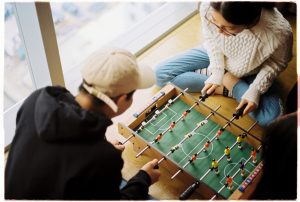
Each activity used in recreational therapy is used for a purpose. Patients with Alzheimer’s may use memory games and do crafts that help link synapses in the brain. Individuals with balance issues can try bowling which helps develop balance and strength simultaneously. Exercise, dance, music and other creative expression activities help with a range of mental health illnesses.
Pet therapy is another form of recreational therapy. One type is “Beta Fish Therapy” which can lower blood pressure and depression, simply by observing the tranquil, beautiful fish. Balancing stones on top of one another is a concentration activity that promotes mindfulness and stress management.

If you think you or someone you know may benefit from recreational therapy, talk to your healthcare provider. Most practices have a referral process in place and can direct you to the proper therapy provider.
For more information and resources on Recreational Therapy, visit our National Wellness Calendar. Join us in February as we spread awareness about Recreational Therapy Month by sharing this blog post!
Cervical Cancer is Preventable
Tuesday, November 26th, 2019
January is Cervical Health Awareness month to raise awareness about HPV vaccination and prevent cervical cancer. Currently, 13,000 women in America have cervical cancer. Millions more have the HPV virus, which is the most common cause of cervical cancer. The critical thing to note this month is that deaths due to cervical cancer are preventable.

What is HPV?
Human Papillomavirus Infection, commonly referred to as HPV, is a prevalent virus. Nearly 80 million people in the United States are infected. This virus can be spread through sexual activity. Since many who are infected never exhibit any symptoms, it can be easily spread without realizing. This is why regular exams are so important.
Mild cases of HPV can produce genital warts, while extreme cases can lead to Cervical Cancer. There is no treatment available for HPV, which is why the vaccine is so important. Prevention is possible.

The HPV Vaccine
Doctors recommend that both boys and girls receive the HPV vaccine beginning at age 11 or 12. Receiving the vaccine at such an early age ensures a better and stronger immune response. Usually, only 2 doses are necessary for children under age 15. In adulthood, it may take up to 3 doses of the vaccine to achieve the same result. Individuals can receive the vaccine through age 45.
Beginning at age 21, women should receive a pap screening every year. Women over 30 should receive both a pap test and HPV test regularly. Most insurance plans cover cervical cancer screenings, so all preventative care should come at no additional cost to the patient. This makes it even easier to prevent Cervical Cancer.

Early Detection is Key
Regular cervical screenings can detect any abnormal changes in cells before they become cancerous. So even though there is no treatment, prevention is very simple. It’s simple because all it takes is to keep up with your regular well check-ups.
Help us spread the word and promote awareness about Cervical Cancer prevention. The tragedy of deaths by Cervical Cancer can be prevented with regular screenings and follow up care. Visit our Wellness Observance Calendar for resources and information to help us spread awareness.
5 Things You Never Knew About Your Liver
Tuesday, October 22nd, 2019
If I asked you what the most important organ in your body is, what would you answer? You’d probably say, your heart or maybe your brain. Some might even think of their lungs. All these organs are indeed essential to life. But there’s another incredibly important organ, essential to life, that often goes unnoticed: the liver. The liver is the largest solid organ in your body and is responsible for more than 500 functions. More than 500 because its functions are still being explored! We still don’t know the extent of its importance. Our bodies are incredible! Let’s explore 5 things you never knew about your liver and how we can keep it functioning in tip-top shape.
1. The Liver is Like a Starfish

Your liver is the only organ that can regenerate. Liver disease in extremely common and can lead to liver cancer. Liver cancer only occurs in people with a preexisting condition, such as obesity, hepatitis or alcohol abuse. In some cases, individuals have had the diseased portion of their liver removed. Many have gone on to live healthy lives with only part of their liver in tact. This is because it’s able to regenerate to its full size in a matter of mere months.
2. It Gives You Energy

Your liver breaks down carbohydrates and turns them into glucose: your body’s energy source. It stores glucose in the form of glycogen and is able to tap into it whenever you need a burst of energy! This why low blood sugar means low energy. Be sure to give your liver some complex carbs and whole grains to use as fuel so you don’t crash and burn.
3. It Keeps You From Getting Sick
Within the liver are a large number of cells necessary for your body’s immunity. These are called Kuppfer Cells or “KC”. Kuppfer cells are disease-fighting agents that fight off any bad gut bacteria that could make you sick. So when your body is fighting off an infection, thank your liver!
4. Helps You Lose Weight

This one is multi-faceted. Firstly, the liver produces bile. Bile is used to break down fat, cholesterol and vitamins so that they can be used by your body. Without your liver, carbohydrates, fats and proteins wouldn’t be able to be metabolized properly. Because of your liver, your body can use fat and carbs for energy rather than just storing them as extra weight. It’s also able to remove excess hormones from the body like estrogen and aldosterone. Too much of these hormones can lead to weight gain. Detoxing your liver may aid your weight loss efforts by enabling your liver to do its job more efficiently.
5. Poison Control
Perhaps the one thing you already knew about your liver is that it’s your body’s filtration system. It filters impurities and toxins from your blood and aids your digestive system. This is why consuming large amounts of alcohol and medications can be so damaging to your liver. Think of your air filter in your home or your car. What happens to it after a period of time? It starts looking really dirty and gross. It can’t function as well after all that filtering of poisons in your body.

Cleaning the Filter
So how do we reboot our liver and keep it functioning well? Even if you don’t use alcohol, the regular breakdown of proteins can create toxins in your bloodstream. Your liver is always filtering out the bad stuff. Taking a supplement with milk thistle and dandelion root is an excellent way to detox your hardworking liver. Turmeric, garlic, green veggies and even drinking tea have also been shown to have detoxing benefits. Basically eating a healthy diet and lifestyle is the best way to care for your liver.
October is Liver Cancer Awareness Month. Visit our Wellness Observance Calendar for more information on keeping your liver healthy.
5 Ways to Help End World Hunger
Thursday, October 17th, 2019
As I walked into the coffee shop to get my $2 coffee, I glanced out the window and saw him. Easily overlooked, he wasn’t even visible under his thin, tarp-like blanket covering him from head to toe. Next to his sleeping body was a crudely written sign that read simply, “Just hungry.”
The sincerity of his message was unmistakable and my heart slowly broke in two. I thought about the comfort of my vehicle I would head back to as I sipped my coffee, my sweet, loving family inside, the food in my pantry and my large, warm bed. Moments ago I had lamented to myself some lack I perceived in my own life. In this moment, seeing this man’s vast lack of common necessities, I felt like a Queen living with every luxury. I had everything I needed. His basic needs remained unmet.
Tears began to cloud my vision as these realizations flooded my mind. Love overwhelmed me and I thought, “No one should ever be hungry. There’s just no need for it.” Yet so many walked by him without a single thought. He was part of the regular landscape of their surroundings.
That day, we took a few extra minutes and bought him some food. He remained asleep when we left it by his side. Who knows if his sandwich was still warm when he awoke. Where would his next meal come from? Would he sleep there again that night? Only God knows. I wished we could do more.
This past week on October 16th, we observed World Food Day – a day dedicated to increasing awareness about hunger and nutrition. While hunger continues to plague underdeveloped countries, it’s a very real issue right here in the US as well. Many times hunger and obesity coexist due to foods high in starch, fat and sugar being more readily available and affordable than whole, fresh foods.
Most of us have plenty to eat, too much even. We throw good food away or let it go bad. It doesn’t matter. We’ll just buy more. What if we could do more? Take a little from what we weren’t going to use anyway, cook a few more meals at home instead of going out to eat and feed someone in need. We’ve researched some concrete ways to help the hunger issue across the globe.
1. The Power of 5
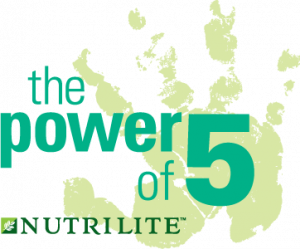
Nutrilite, an organic vitamin and supplement company created The Power of 5 Campaign in 2014 to fight childhood malnutrition. They developed a micronutrient supplement they call “Nutrilite Little Bits for children ages 6 months to 5 years old. They target children because malnutrition affects them most. If they don’t get the necessary nutrition in those critical first five years of life, their little brains and bodies won’t develop properly.
So far The Power of 5 has been able to help 31,455 children in 15 different countries. You can help them feed these children. Plan an event to help raise awareness and funds or you can donate funds yourself. Just $10 will support one child for an entire month. Pack a lunch to take to work one day out of the week and you can feed 4 children. Do it every day and you can feed 30.
2. Backpack Programs

Millions of children in the United States receive two hot meals at school each day. But those meals may be the only ones they get. Feeding America started Backpack programs over 15 years ago to help feed these undernourished children on the weekends. Over 450,000 bags of food are distributed to these hungry children and with our help, they can feed even more.
Contact your local food bank to find out if there is a backpack program in your area. If not, maybe you can help start one. If you’re in the Raleigh, NC Triangle area, look into Backpack Buddies for ways you can help the children in our community.
3. Donate to Food Banks
All of us have brought a can of green beans or ravioli to a food bank drive around the holidays. What is unfortunate is that much of the nonperishable foods donated tend to be void of much nutrition. Junk food and sweets, while tasty, don’t do much to sustain those suffering from hunger and malnutrition.
Here’s a list of good choices of food and other items to donate:
- Beans and grains
- canned vegetables and fruit
- canned protein
- peanut butter
- instant foods that only need boiling water (pastas, rice, oatmeal, instant mac and cheese)
- pickles, olives
- popcorn
- bottled water
- feminine products
- diapers
- toiletries
- your time. It means a lot to give of your time to volunteer and it’s usually much needed.
Did you know food banks actually accept donations at other times besides the holidays? Check-in with your local food bank throughout the year to find out what they might need most.
4. Action Against Hunger

For more global hunger issues, this organization is making a huge impact. They’ve fed 21 million people in 47 countries. They are very clear about where their donations are going and make it evident that 93% of their money goes straight to their programs.
This organization not only cares for malnourished children but also their families. They provide aid after natural disasters and help equip people to better care for themselves.
“We enable people to provide for themselves, see their children grow up strong, and for whole communities to prosper.” That’s a worthy cause to get behind. Click here to donate.
5. Host/Attend a Meal Packaging Event

Since it’s inception in 1998, the Rise Against Hunger organization has sent out over 500 million meals to hungry people around the world. These meals were packaged and prepared by volunteers like you and me. You can host a meal packing event as a family, a church or any organization. They utilize groups of all sizes.
You’ll assemble bags of rice, soy, and nutrients in assembly-line fashion. It’s a great way to get involved personally and get excited about the impact you can make by giving of your time and energy. It’s just a few hours of your time but makes a world of difference to each individual who receives that nutritious meal.

We hope you’ll find at least one area on this list that you can take action on today. Together we can end world hunger. If each of us does a little, it will add up to more than enough. Do your part, spread the word and we really can achieve zero hunger.
Down with a Dream
Monday, October 7th, 2019
In October, we observe Down Syndrome Awareness Month. It’s a great time to celebrate all the wonderful things that people with Down Syndrome are doing around the world. Gabrielle Angelini is just one of those inspiring examples. She’s taken perceived limitations and proven that they are no match for a dream and determination. As a business owner and rising internet sensation, she’s spreading her message of hope and overcoming far and wide. We’re pleased to be sharing her story with you today.
A Hug In A Mug
Gabi’s road to success begins like most when everything looked bleakest. After graduating from high school, she was hard-pressed to find a company that would hire her. Perhaps the most important thing to communicate this month is dispelling myths surrounding those with Down Syndrome. Employers assumed that because Gabi was different, she may be slower and less able to perform on the job.
It turns out all of that rejection was just the fuel Gabi needed to make an even bigger impact, not just in her own life, but in the lives of others. If no one else would hire her, she would create her own company and provide jobs for others in her same position. Gabi is a great example of entrepreneurship at its finest! With the help of her mom Mary, they created Gabi’s Grounds Coffee Shop: A Hug in a Mug. When asked about her company’s slogan, Gabi explains with a smile, “A hug in a mug, because I’m a hugger.”

Get Gabi’s Off The Ground
Gabi’s Grounds was founded in 2017 with tee shirts, mugs and of course, coffee. You can find Gabi’s own special coffee blend at numerous major grocery chains like Lowes Foods and Harris Teeter. Even with all this success, Gabi’s dream isn’t complete. She wants to open her own brick and mortar storefront for the coffee shop. You can play a part in helping her do that!
On November 3, the “Get Gabi’s Off The Ground” fundraising event will be held at Plus Dueling Piano Bar in Raleigh. Tickets are available now at a special price of $35. They include dinner, live music and the chance to win some really special prizes like a trip to Disney as well as Myrtle Beach. If you’re not local to the Raleigh area, visit Gabi’s Grounds page on Facebook to stay up to date on Gabi’s adventures and other ways you can support her and her business.
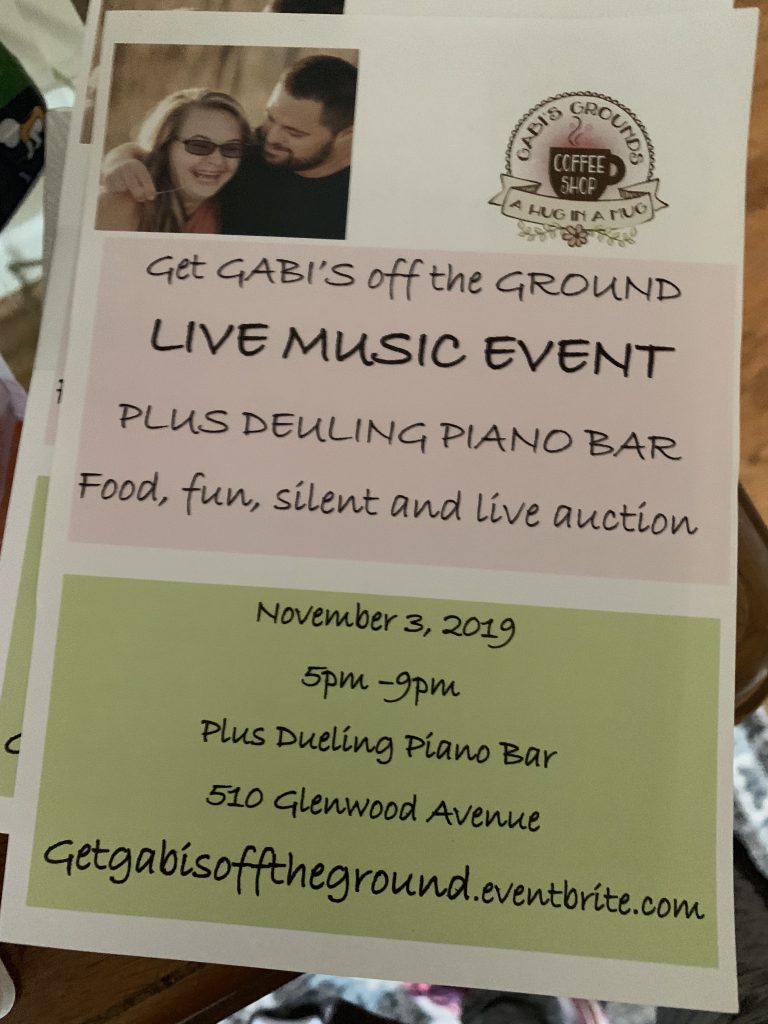
Down With Love
In addition to Gabi’s business pursuits, she found love along the way with Nick. They met at a special needs conference and hit it off. While they keep up a long-distance relationship, their parents recently arranged a surprise reunion that went viral on the internet! Their sweet affection for one another is enough to bring a tear to even the driest eye.
Watch Gabi & Nick’s Surprise Reunion!
Now with over 3 million hits, the video is catapulting Nick and Gabi into the eye of the public, furthering their message of hope and overcoming. They have their own Facebook page too!
You Can Too!
Gabi’s ultimate message to others is that they can do it too. You can follow your dreams and achieve them if you keep on trying and never give up. Mary expresses something we all understand when she says that life is hard for all of us. But for those with special needs, it can be even more difficult. Gabi has had the opportunity to share at multiple special needs conferences and cheer her peers on! Mary has watched Gabi blossom over the last few years as her confidence has grown. In a recent interview for The List TV, Mary said this about her daughter, “She’s who she’s supposed to be and everybody deserves that chance.”
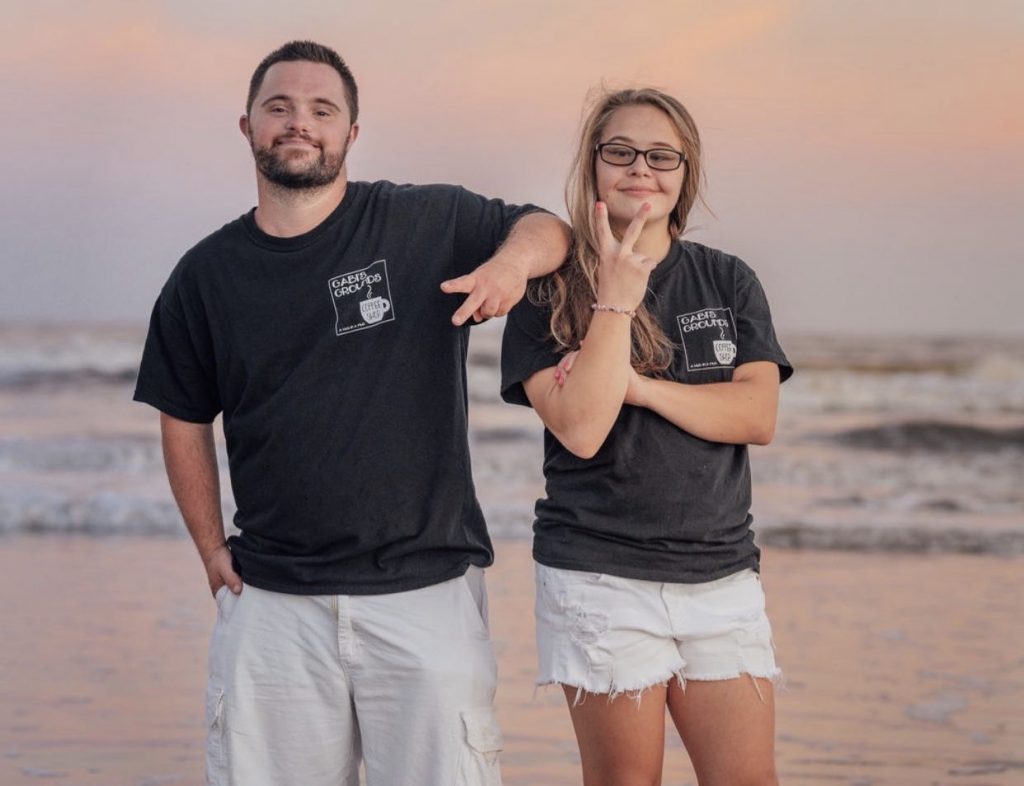
Why Are You Still Getting Cavities?
Monday, September 30th, 2019
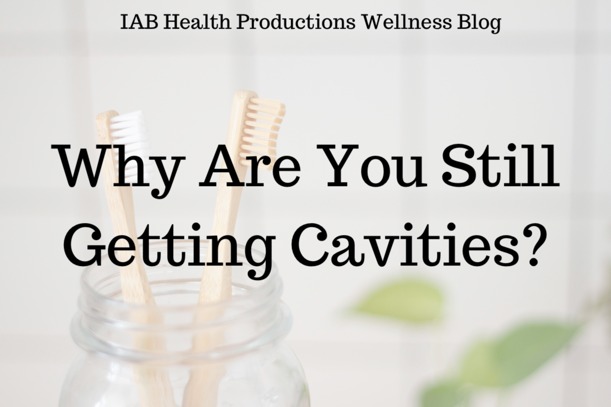
Most of us have grown up hearing that in order to avoid cavities we should brush and floss twice a day. People with exceptionally good oral hygiene may even opt to brush after meals as well. We’ve been told that the acid and bacteria in food is what breaks down the enamel in our teeth and leads to cavities. What if you do all that and you still get cavities? Do you just have bad teeth? Is your enamel weaker than normal? Maybe. But what if good oral hygiene just isn’t enough? Here are a few lesser-known tips to help you keep your teeth healthy and cavity-free!
Don’t Brush After Eating
Resist the urge to brush your teeth immediately after eating. This one may be surprising but it’s true. Every time we eat, especially acidic foods, our teeth come under “attack.” The enamel is weakest just after eating. It takes about thirty minutes to an hour for your teeth to recover from the acidic attack. Brushing just after eating can actually push the acid into your teeth, furthering the damage being done. Rinsing your mouth with water is recommended rather than brushing. If you must brush after eating, wait at least thirty minutes after your meal.
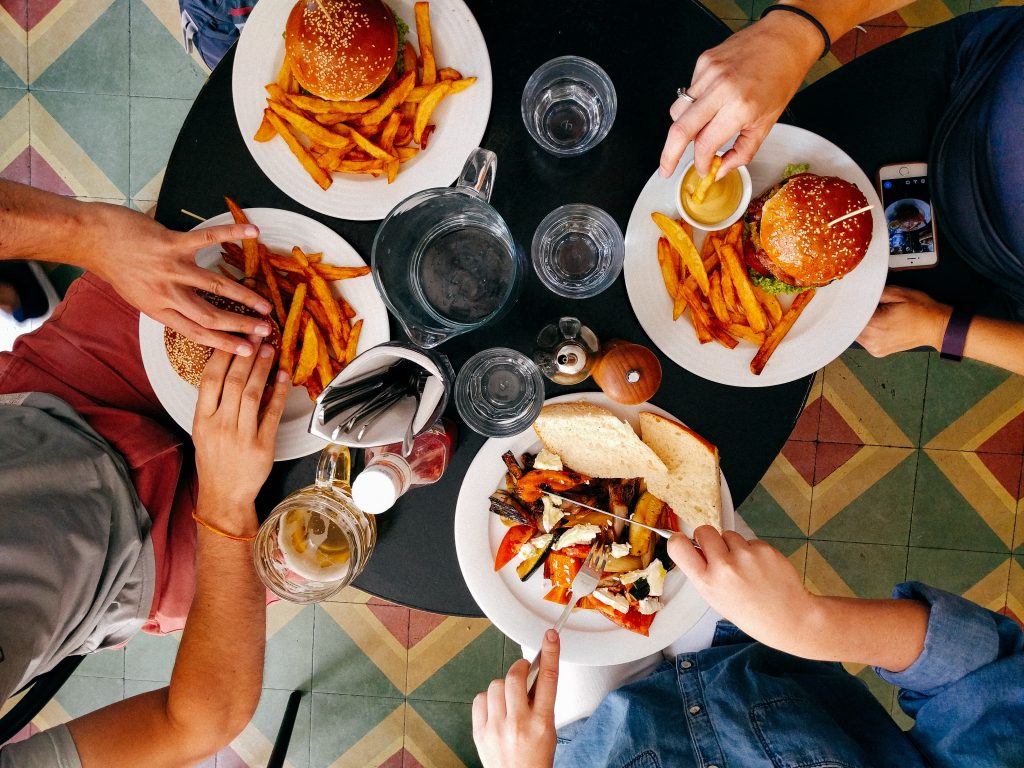
Eat Less Often
We’ve already mentioned that it can take up to an hour or more for your teeth to recover from eating. If you are prone to snacking or eating small meals throughout the day, your teeth are at increased risk for damage. Cavities are more likely to form since your teeth are being repeatedly accosted by bacteria and sugars. Even if you’re not addicted to sugary sweets and soda, pasta and other simple carbs can still turn to sugar on your teeth.
Eating three regular meals is recommended as opposed to eating more frequently throughout the day. This gives your teeth a chance to re-mineralize to withstand the next exposure to food. If you find you seem to get cavities more frequently than others, despite your good oral hygiene, you may need to adjust your eating habits.
Choose Hot over Iced

Do you drink coffee? Regardless of potential tooth staining, the temperature of your coffee may have an indirect effect on your propensity for developing cavities. We tend to drink hot coffee more quickly than iced coffee. This is obviously because we want to drink it while it’s hot before it cools down too much. Iced coffee or soda is something we may sip on for several hours. Since it takes us longer to drink, our teeth remain vulnerable over a longer period of time.
Can’t give up your iced coffee habits? Just be sure you’re not taking your time with it. Choosing a smaller drink size may help you finish more quickly and even cut down on your sugar intake. Follow up your coffee drinking with some ice-cold water to help rinse your teeth.
Use a Mouthwash with Fluoride
If you find you end up with cavities at every dental visit, you may be missing a key element in your hygiene routine: fluoride! In addition to fluoride toothpaste, check your mouthwash. Some mouthwashes are merely antiseptic, meant to kill bacteria that cause bad breath. Find a mouthwash that also includes cavity protection. These mouthwashes are infused with fluoride and will help fortify your enamel against caries.
Visit Your Dentist Regularly
It’s recommended that children begin seeing a dentist from the time their first tooth appears, and every six months after that. As adults, we can typically go for longer stretches of time between dental visits. However, if you’d had lots of tooth decay or other dental issues, you may need to schedule your visits more frequently. Dentists can identify areas of tooth decay that you may be unaware exist. If identified early enough, some tooth decay may be reversible before it becomes a cavity that needs filling.

Good dental health is essential to our overall health and well being. It even contributes to our self-confidence. A smile is often the first thing others see! We hope this article helps you keep yours looking bright and healthy! Visit our National Wellness Observance Calendar for more information on Dental Hygiene Month during the month of October.
Midwifery: Advocating for Healthy Birth
Wednesday, September 25th, 2019

Below you’ll find the personal story of Amanda Zopp, writer and social media manager for IAB Health Productions. Following her personal experience, we’ll include some additional information about midwifery.
Before I became pregnant, I always feared labor and delivery. I was confident that I would want ALL the drugs and even hoped I might be able to opt for a C-section. However, something changed when that little life was inside me. I started reading more about the birthing process, the impact drugs could have on my tiny infant and the journey of breastfeeding. I felt a little strange about the prospect of breastfeeding, but I was willing to push past that and the pain of childbirth if it was the very best thing for my baby.
After learning more and realizing my body was designed to birth a baby, I gained a new level of confidence and determination. I went the opposite route and decided, I wanted a natural, drug-free childbirth! I excitedly went to the OB-GYN at 6 weeks along for my first ultrasound.
Scheduling a C-section at 6 weeks Pregnant
When I got there, I began filling out my paper work, medical history etc. When the doctor came in to speak with me she began telling me that due to a pelvic surgery I’d had ten years prior, we would go ahead and schedule my c-section. I was distraught! That wasn’t what I wanted at all. I attempted to explain to her that my orthopedic surgeon had assured me I would have no trouble in childbirth. I had long since healed. I could run, jump, bend! I was very flexible and had even completed the Beach-body Insanity workout, known for its strenuous plyometric exercises. Her only response to me was a blank, “We’ll see.” But that we would go ahead and schedule the C-section. She told me she was concerned about the long-term effects of holding my legs in a position for childbirth over a long period of time. I knew when she said it that the doctor was likely more concerned about a potential lawsuit than any physical effects on me.
She left the room and holding back tears, I turned to my husband and said with determination, “We’re going somewhere else.” I’m so grateful that I knew enough even then to be own best advocate. Women should be in charge of the births they want to have, barring any high risk situation (which mine was not).
A Midwife: Support System and Advocate
I began looking into Midwives in my area and found two Certified Nurse Midwives that were part of a practice with other OB-GYNs. That put my mind at ease. I would be seen by everyone in the practice, but primarily by a midwife. At my first visit, I explained to her the previous doctor’s concerns. The midwife looked at me and matter of factly asked, “Can you squat? Get on your hands and knees? There’s more than one position to birth a baby. If your operating physician said you would be fine, that’s all that matters.” Instantly I felt relief. I was going to have her support to have the birth I wanted, with as little intervention as possible.
I’m happy to report that I have since given birth naturally, drug-free to two children. I’ve had no residual pain or impact on my old injury. I was also able to successfully breastfeed both children until a few months past a year old. Having the support of the midwives felt like a partnership. I had a say in how I wanted my births to go. That was important to me and so empowering. Birth is not an illness. It’s a natural process of life. Women have been birthing babies since the beginning of time. If they could do it then, we can certainly do it now. Explore your options. Find a provider who will listen and give you the best birthing experience possible. You deserve that.
~ Amanda

Both a Midwife and OB-GYN are Important
Both OB-GYNs and CNMs are able to provide prenatal, gynecological and primary care in addition to delivering babies. OB-GYN doctors are skilled and trained to handle any complications or issues that may arise. They are trained to intervene. If you’ve ever given birth or seen someone give birth, you know that the doctor who “delivers” the baby, oftentimes merely catches it. The mom is doing all the work!
Midwives are a great choice for any normal pregnancy and delivery. They typically place more emphasis on a woman’s own physiology and ability in childbirth. They seek to avoid and decrease unnecessary intervention. Ninety-four percent of deliveries by Midwife takes place in the hospital. In situations of high risk or medical emergency, OB-GYN’s are the most qualified. Midwives are able to work in partnership with doctors to provide the safest and best experience for the mother, baby, and family.
National Midwifery Week
The American College of Nurse-Midwives has created National Midwifery week, observed September 29th – October 5th, 2019. This week is designed to celebrate and show appreciation for our midwives. We can also use this week to share our stories, spread awareness and promote healthy birth across the nation. Visit our Wellness Observance Calendar for more information.
Mental Health & Suicide Prevention
Tuesday, September 10th, 2019

The assault on our mental health is a daily battle we each face. Some of us fare worse than others. It’s important to understand how to cultivate good mental health. When we keep our minds healthy, we help prevent suicide. We must also be aware of the struggle in others. Mental struggles are all but invisible. It takes intentional effort to know each other well enough to sense when something isn’t right. We must express care and concern about the internal struggles of our loved ones. As a community, we must encourage and lift each other up.
Good Mental Health Habits
- Get Enough Sleep
- When we don’t get enough rest, our minds can become unhinged. Irritability, moodiness and depression set in. Read more about the correlation between sleep and mental health in an article from the Harvard Medical School website.
- Eat a healthy diet.
- Nutrition has a major effect on our energy levels and overall mental wellness. Certain foods can make us feel sluggish and glum. Other foods can actually brighten our mood and give us energy.
- Exercise
- Exercise has to be one of the single most effective tools for our mental health. Getting your heart rate up releases those feel-good endorphins that keep us upbeat and positive. Start your day with a good sweat session and you’ll feel ready to take on the world.
- Socialize
- Yes, even for introverts, socialization is important. When we keep to ourselves, we’re alone with our thoughts and create even more isolation. It’s easy to feel alone, even in a crowded room. But when we engage in real conversation with others, it broadens our perspective. When we share in each other’s struggles and victories, we are operating in a community with one another. It is in sharing our lives with each other that we begin to understand how we are all truly more alike than we are different.

- Don’t Be a “Yes Man”
- Know what healthy boundaries you need to keep in place for your mental health. Try not to wait until you’re at the end of your rope to take a break. It’s important to rest, to be alone with your thoughts and process. Some people keep so busy that they never really know how they’re feeling until they’re too far down the wrong path. You can do anything, but you can’t do everything. Knowing when to say no is an important thing to learn.
- Put Your Phone Down
- Our phones never leave our side. Hours can go by with you just scrolling through other people’s lives. There’s a constant barrage of information coming at your brain and the stimulation can be mentally exhausting. We are more connected by social media than ever before, yet most of us are realizing just how shallow and isolating that connection tends to be. Make sure you put your phone down once in a while and talk to a human face to face. Turn your phone off and put it in a drawer for an hour or two and feel the freedom of not checking it every few seconds.
- Get Outside
- There’s something very grounding and clarifying about being in the outdoors. Going for a quiet walk around the neighborhood or watching the sunset can do wonders for your mental well being. Don’t underestimate the simplicity of getting more oxygen to your body by being outside. Observing how nature is functioning around you is a great reminder that the world is bigger than you and that everything will be all right.

Signs of Poor Mental Health
- Isolation
- Staying in a never going out. Insisting that you have too much to do when really you just can’t bear to be around others. You may even hold the belief that you’re the only one who knows what you feel like. No one else has felt the way you do. No one will ever understand.
- Depression
- When depression sinks in, every day it’s a struggle just to function. Getting out of bed is a huge accomplishment. Sadness or general indifference permeates every single day.
- Comparison
- Constant comparison with others can make us feel lacking in every area. Even though we know that what we see on TV, movies, or even on social media is curated to look a certain way. We are never seeing the full story. Yet mentally we may begin to feel as though we can never measure up. When we start to compare we become focused on what we lack, instead of what we have. We find our relationships, homes, clothing, finances, all come up short when compared to what we see.
- Hopelessness
- Feeling as though things will never get better, that we’ve screwed up too much or missed our chance perpetuates feelings of hopelessness. The truth is that there is always hope. But when you are caught in a cycle of hopelessness, that can be difficult to believe.
Poor mental health can easily lead to a thought process that may end in suicide. If you have thought about ending your life or believe the world would be better without you, please reach out to someone. Let them prove you wrong. Come up with a safe action plan to protect you from those dark thoughts. You are important and valuable and we need you here.
How Can We Help?
If you or someone you know is showing signs of poor mental health, here are some steps to take. Being equipped with the right expectations and resources for our mental health and the mental health of others is a starting point for winning the fight against Suicide.

- Be Bold. Ask Pointed Questions.
- Don’t be afraid to be awkward or embarrass yourself by asking someone if they’re planning to commit suicide. Their life may depend on your boldness. Isn’t that worth more than what someone may think of you? Ask exploratory questions: Have they made a plan to do it? Do they have access to the resources they need? Let them know you are coming to help them or encourage them to go to someone they feel safe with.
- Talk About It.
- Share your stories. Not everyone has the signature signs and symptoms. Sharing the stories of loved ones you’ve lost to suicide or how you overcame an attempt on your own life can potentially save the life of someone else.
- Be present and aware.
- Don’t let people slip through the cracks. Learn people’s names and let them know they’re valued by you. You never know what a smile or kind word may do in the life of someone else. It could mean the world to someone starved for love and attention.
- Be others-focused.
- We all have our own issues we are working through. When we focus on our problems, they tend to grow. When we look outside ourselves to the needs of others, we not only help them. We help ourselves in the process. If each of us focused on the well being of the person next to us, we’d all be taken care of. It has to start somewhere. Why not with you?
- Forgive Yourself.
- If it’s too late for someone you love, know that you’re not at fault. You can do everything “right” and still lose someone. Give their life more meaning by sharing their stories and helping someone else. Be kind to yourself and honor their memory.
For further information or assistance visit our wellness observance page or call 1-800-273-8255 to talk to someone any time of day. An online chat is also available to you right now.



